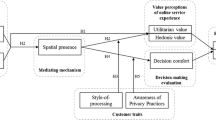Abstract
This paper addresses the problem of the relationship between humans and technology-enhanced spaces and physical objects (later defined as artifacts). The class of cases here analyzed includes interactive digital signage, information kiosks, home media centers and interactive spaces whose purpose is the communication of a meaning. In this domain, complex interfaces are not needed, as common people interaction with information, content and media is in most cases extremely simple. The topic of specialized interfaces for expert users is not addressed here; the focus is on interfaces for the general public, whose main purpose is the basic fruition of digital information, although such information can be large and complex in its organization. This paper is centered on the need of conceiving computer sensing and information presentation as different aspects of the same interaction design problem, instead of separate research entities.
Similar content being viewed by others
References
Bederson B, Hollan J (1994) “Pad++: a zooming graphical interface for exploring alternate interface physics.” Proceedings of User Interface and Software Technology
Chang BW, Ungar D (1995) Animation: from cartoons to the user interface. Technical Report TR-95-33, Sun Microsystems
Colombo C, Del Bimbo A, Valli A (2003) Visual capture and understanding of hand pointing actions in a 3D environment. IEEE Trans Syst Man Cybern B Cybern 33(4):677–686
Dourish P (2000) A foundational framework for situated computing. CHI 2000 Workshop on Situated Computing
Natural Interaction. http://naturalinteraction.org/projects.html
Ishii H, Ullmer B (1997) Tangible bits: towards seamless interfaces between people, bits and atoms. Proceedings of the SIGCHI Conference on Human Factors in Computing Systems, Atlanta, USA
Mazalek A, Davenport G, Ishii H (2002) Tangible viewpoints: a physical approach to multimedia stories. Proceedings of the tenth ACM International Conference on Multimedia, Juan-les-Pins, France
Mitchell W (1999) e-topia: urban life, Jim—but not as we know it. MIT Press, Cambridge, MA
Norman D (1990) The design of everyday things. Doubleday, Garden City, NY
Norman D (2003) Emotional design. Basic Books, New York, NY
Pentland A (1996) Smart rooms, Sci Am 274(4):68–76
Sparacino F (2002) Narrative spaces: bridging architecture and entertainment via interactive technology. 6th International Conference on Generative Art. Milan, Italy
Sparacino F (2003) Sto(ry)chastics: a Bayesian network architecture for user modeling and computational storytelling for interactive spaces. Proceedings of Ubicomp, Seattle, USA
Weiser M, Brown JS (1995) Designing calm technology. Xerox PARC
Author information
Authors and Affiliations
Corresponding author
Rights and permissions
About this article
Cite this article
Valli, A. The design of natural interaction. Multimed Tools Appl 38, 295–305 (2008). https://doi.org/10.1007/s11042-007-0190-z
Published:
Issue Date:
DOI: https://doi.org/10.1007/s11042-007-0190-z




